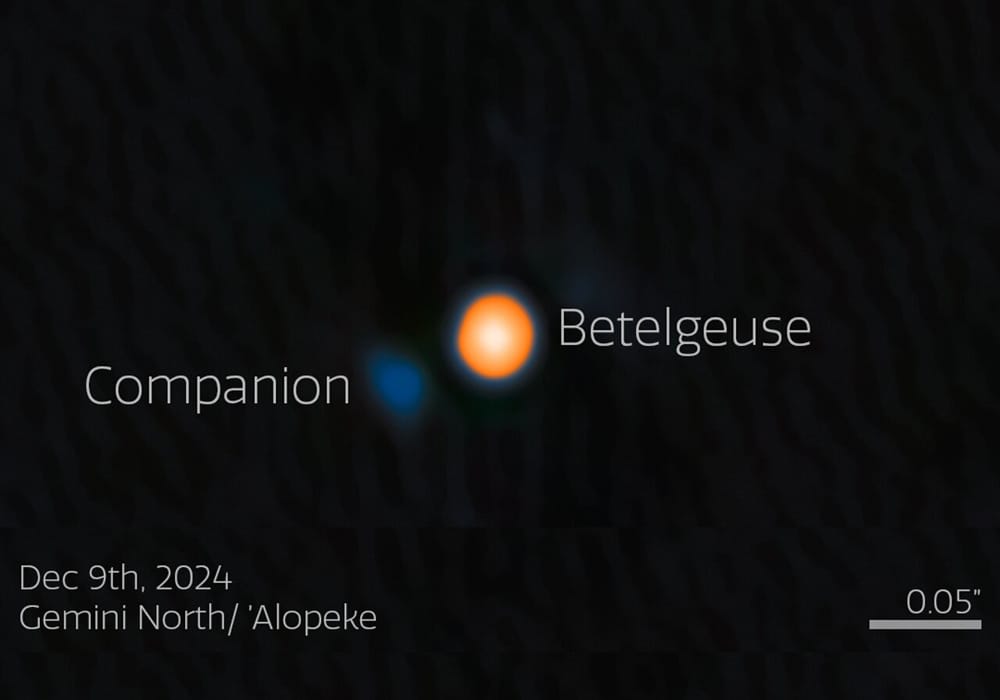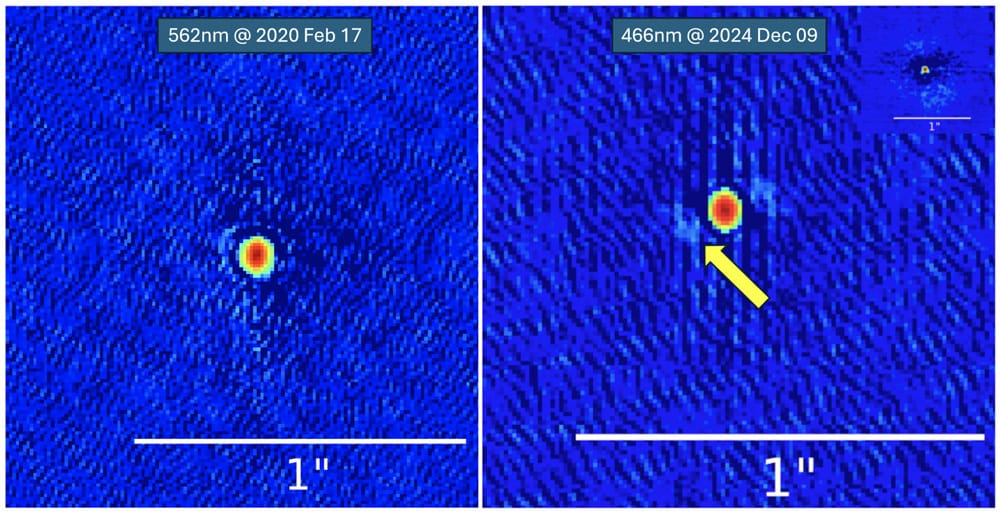- Bad Astronomy Newsletter
- Posts
- A second star for Betelgeuse?!
A second star for Betelgeuse?!
Astronomers post a possible binary companion for the soon-to-be supernova

The Trifid Nebula and environs. Credit: RubinObs/NOIRLab/SLAC/NSF/DOE/AURA
July 28, 2025 Issue #910
A binary companion for Betelgeuse?
Astronomers may have directly imaged a smaller star orbiting the red supergiant
I have cautiously exciting news: Astronomers may have directly detected a star orbiting Betelgeuse, a smaller binary companion that would solve a long-standing mystery about the enormous red supergiant [link to journal paper].
Betelgeuse is, famously, a star on the edge. It’s very massive, roughly 15 times the mass of the Sun, and at 10 or so million years old is already well on its way to a spectacular death: a supernova, an explosion that will blast away its outer layer while its core collapses to form a neutron star or black hole. That may not happen for 100,000 years, but at the moment its core is blasting out enough energy to cause the outer layers to swell up to immense size (roughly a billion kilometers across!) and cool, turning it orange-red.
It’s also somewhat unstable. A big example of that is how in 2019/20 it dimmed hugely because it blew out a vast cloud of opaque dust that partially blocked its light. But even so, for centuries we’ve known it changes in brightness over time. It dims and brightens slightly and fairly regularly on a 400-day cycle, due to changes in its surface that get their start deep inside the star.
But there is a second variation on top of that, where it dims and brightens on a roughly 2,000-day (6 year) cycle. The cause of this has been unknown. A lot of work went into trying to figure out if some weird internal dynamic was causing it, but in the end the best guess was that Betelgeuse has a binary companion, a star orbiting it with a 6-year period, and we see that orbit very nearly edge on. They’re too close together to see separately, so from Earth (about 550 light-years away) we see Betelgeuse dim when the smaller star goes behind the supergiant, than brighten again when it reappears some months later.

Betelgeuse prime is the red blob in the center of this highly processed image, with the secondary star indicated. Credit: International Gemini Observatory / NOIRLab / NSF / AURA. Image Processing: M. Zamani (NSF NOIRLab)
Several papers came out a few years ago trying to nail down some properties of this companion star, and while the conclusions are a bit vague — Betelgeuse is a tough star to study since it’s so bright big telescopes have a hard time observing it, and as a red supergiant its outer portions change a lot over time — they converge on a star around the mass of the Sun. Since it’s 10 million years old the star hasn’t really settled into calmly fusing hydrogen into helium in its core (it’s what we call pre main sequence). Its position along its orbit can be roughly predicted, and they found it was behind the big star during the Great Dimming event, but would be at greatest elongation — where the separation between the two is greatest — in 2024.
Join over 4 million Americans who start their day with 1440 – your daily digest for unbiased, fact-centric news. From politics to sports, we cover it all by analyzing over 100 sources. Our concise, 5-minute read lands in your inbox each morning at no cost. Experience news without the noise; let 1440 help you make up your own mind. Sign up now and invite your friends and family to be part of the informed.
So a team of astronomers decided to see if they could find it. They used Gemini North, a telescope in Hawai’i with a huge 8.1 meter mirror. Here’s where things get fun. The ‘scope is so huge it gathers a lot of light, so any regular image of Betelgeuse would be hopelessly overexposed. So instead they took extremely short exposures, each between 10 and 60 milliseconds in length. This prevents the image from saturating, but it also does something even more important: it freezes out the motion of the air in the sky above the ‘scope.
Our air is in constant motion, and as starlight passes through it the path the light takes gets jostled to and fro, smearing out a star’s image. By taking very short exposures this motion is minimized, so each image is extremely sharp. Betelgeuse is so big that it appears to be about 50 milliarcseconds in size (an extremely small angle on the sky) but the Gemini ‘scope has a resolution of just 10 milliarcseconds, so each image should show a resolved disk for the star. The separate images were then combined mathematically to produce a well-exposed and sharp image of the star, even though it was only a few pixels across.
They observed Betelgeuse in 2020 during the Great Dimming, when the companion star was predicted to be behind the supergiant, and saw nothing, as expected. Then they observed it again in 2024 at greatest elongation, and that’s when they saw something amazing: a faint blob of light next to the star!

Left: the 2020 observation showing nothing near the star. Right: the 2024 observation showing a faint bluish patch to the lower left which may be the companion star (the patch to the upper right is a “ghost” of the patch produced mathematically when the thousands of individual images are combined). At the upper right is the size of an unresolved star for comparison to Betelgeuse which is resolved. Credit: Howell et al. 2025
By itself the blob is not statistically significant, meaning you can’t claim it’s real. This is like flipping a coin three times and having it come up heads all three times. That’s interesting, but does it indicate an unbalanced coin? You can’t say without flipping it more times.
But there’s more to it than this. The blob is in the predicted position for the second star, and it’s also about the predicted brightness (about 0.5% as bright as the supergiant). And it’s not seen in the 2020 observation, so that’s also as predicted.
So while we can’t say for sure they saw the companion star, it looks probable they did. The best way to know, of course, is to observe again at greatest elongation, and the next one is in 2027. I expect someone will take a look again then.
If it’s real, then it orbits the primary star at a terrifying 1.4 billion kilometers from its center. From its vantage point, the red supergiant would fill nearly the whole sky! Yikes. Also, Betelgeuse prime doesn’t have a real surface; it doesn’t just stop. Like Earth’s atmosphere, the upper part of Betelgeuse fades with distance from the star’s center, so it’s very likely that this secondary star candidate would actually be orbiting inside the red supergiant’s extended atmosphere. That’s wild.
It makes me wonder about the fate of this star, too. Betelgeuse, after all, is going to explode. Being that close to a supernova isn’t great for your health. Well, first, the star won’t get vaporized. Supernovae are ridiculously powerful but stars are also resilient. It’ll lose some material for sure as the material from Betelgeuse prime screams past it at a fraction of the speed of light. But that doesn’t last very long, and the second star itself should survive. If it’s still coalescing from material around it, like young stars do, then that stuff will probably get blown away. To be honest I doubt there’s much there anyway, since the red supergiant has been cooking it for millennia anyway.
When the bigger star explodes, it’ll lose a lot of its mass, and that means its gravity will weaken, too, so the second star may have enough speed to be ejected from the system, off to roam the galaxy on its own. Or it might stay bound but go into a long elliptical orbit around whatever is left after the explosion. If a neutron star is what remains, then it’ll be fiercely hot and likely have a fast wind emanating from it that will continue to erode the star. If it’s a black hole instead, the star may just stay in orbit around it, though if it gets too close material could get stripped from it to fall into the black hole, which would blast out a lot of high-energy light on its way down. That would be interesting, and hopefully not dangerous to us. It’s not going to happen for a long time, anyway.
So if this star pans out it’s super cool! It explains Betelgeuse’s odd behavior, and would be a nice little triumph for the predictions. It could also help solve another mystery: Betelgeuse’s mass. It’s really hard to know what that is, and the theoretical models are a bit all over the place for it. If there’s a companion star in orbit, and if we can measure the time it takes to go around and the distance between them, then the masses of the stars can be determined using very simple physics. That would extremely helpful for the theoretical models.
Oh, one more thing: Betelgeuse in Arabic can be translated as “the hand of the giant”. Because of that, the astronomers propose the secondary star be named Siwarha: “her bracelet”. Very cool.
Et alia
You can email me at [email protected] (though replies can take a while), and all my social media outlets are gathered together at about.me. Also, if you don’t already, please subscribe to this newsletter! And feel free to tell a friend or nine, too. Thanks!



Reply